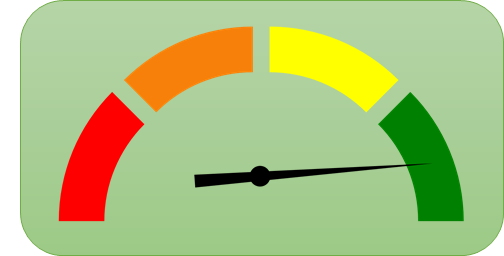Even then, unforeseen circumstances will shake your organization’s foundations. So, prepare, react, recover and reimagine

Reading time: 3 minutes.
A strong purpose proposition requires agility and resilience. Because a positive impact today, can turn into a negative impact tomorrow. Therefore, it’s challenging to stay in the “green zone”. The context changes constantly and when it does, you want to be ready to absorb the shock and recover with ease.
This post is part of a series about technology and organizational positive impact
- A guide to organizational positive impact, tech edition
- Doing good drives profitability
- Major events and big statements
- Be consistent about your positive impact
- A strong purpose proposition requires agility and resilience
- Agility and organizational complexity, beware of the present
- How to create positive impact with technology? Foster critical thinking
- Technology as an accelerator for positive impact
- Assess how technology shapes your organizational positive impact
- Reframe technology’s purpose and strengthen organizational alignment
The Royal Shakespeare Company
How good does a company need to do, to be perceived as a positive force for planet and society? The bar is constantly moving. Consider the actions of the Royal Shakespeare Company. And their consequences.
One of the goals of the Royal Shakespeare Company is to share their work with a wide audience. To accomplish this, the theatre offers tickets at a reduced fee to 16 to 25-year-olds. The difference in price is paid for by a sponsor. Given this information, one might assume that the theatre and sponsor are seen as organizations that contribute positively to society. Such is not the case. A fragment from an open letter:
“If we, as young people, wish to see an affordable play at your theatre we have to help a company that is actively destroying our futures by wrecking the climate”.
Your theatre is the Royal Shakespeare Company. A company is British Petroleum who sponsored the 5 British Pounds tickets. This open letter along with actions from artists, the public and environmentalists, pressured the theatre in terminating the sponsorship deal. Both the letter and the decision by the theatre are covered by mainstream media and put the theatre and BP in an unfavorable light. Interestingly, the theatre meant to do good. But given the backlash didn’t do good enough.
Staying in the “green” zone
This example isn’t an outlier. It proofs to be difficult to stay in the “green zone”. There are several reasons for that. Over time public opinion changes, awareness grows, new insights arise, and innovations emerge. What was once regarded to be best practice, now is mediocre. Or worse, as Optum found out.
Optum is a major software provider for the health industry serving 9 out of 10 US hospitals and reaching 128M individual consumers. Optum, in their own words, aspires to improve experiences and outcomes for everyone they serve while reducing the total cost of care. One of their products applies risk analysis to predict patients in most need of special intervention. Which to me is amazing. And I do see how this simultaneously improves experiences and reduces costs. The journal Science, however, found a strong bias in Optum’s algorithm. Many black patients were given “strangely low” risk scores, despite their deteriorating health conditions.
The importance of agility and resilience
Being able to face unexpected changes to your organization’s context is of paramount importance. These two examples show that it’s vital to be agile and resilient. Even more so because large-scale natural events can present your organization with the unthinkable.
This is clearly demonstrated by the Covid-19 crisis, for example. In the words of the International Monetary Fund: “The Covid-19 pandemic is inflicting high and rising human costs worldwide, and the necessary protection measures are severely impacting economic activity. As a result of the pandemic, the global economy is projected to contract sharply by –3 percent in 2020, much worse than during the 2008–09 financial crisis”.
Specific industries, businesses and households are strongly affected. Leading to bankruptcies and high levels of unemployment. These effects will ripple to other sectors of the economy affecting even more companies and households.
Natural large-scale events have an unpredictable impact on your business. You can’t plan for it. The same is true for “staying in the green zone”. So be ready for the unexpected. The journey to a positive impact is influenced by many variables. It’s paramount that you can respond quickly. In my next post, “Agility and organizational complexity, beware of the present“, you can read my number one tip on agility and resilience. You’ll find my posts and more at SogetiLabs.
Tips
Embrace the shifting context.
Your organization will be presented with unforeseen circumstances. Nothing you can do about that. But you can be ready with a strong purpose proposition, solid roadmaps that involve all layers of the organization and high-performance teams. This will help you to prepare, react, recover and reimagine.
Prepare to be ready for the unforeseen.
Form a permanent quick-response team with organizational key-players across the board: c-level executives, communications, operations, legal. Cover both the communication and content perspective. Put in place basic procedures for and means of secure collaboration. Practice periodically to grow and learn as a team. Evaluate and improve after each real-life incident.
React to stop the fall-out.
Whether it’s a racist remark by an employee, reported abuse, compromised customer data, a crashed plane, a devastating storm or a leaking oil tanker. Your first response matters. It will leave a lasting impression on your stakeholders and impact leeway and future opportunities. Your response is as much about tone of voice as it’s about content.
Resolve underlying issues and mitigate negative impacts.
After successfully reacting, it’s time to be pro-active. Widen the scope of the quick-response force and include professionals that can deal with the specificities of the incident. Put in place specific metrics and tools that will keep the team informed and aligned. Determine the root cause and alternatives to come to a resolve.
Reimagine your role and approach.
Some incidents will have a lasting impact that make it advantageous or necessary to fundamentally change your organization. Think of Boeing and the 737 MAX, Volkswagen and Dieselgate or the Covid-19 crisis and the hospitality industry. Revisit the value generated by your business model. See the tips for that in a previous post, “Doing good drives profitability”.
In general
Leverage on and deepen stakeholder collaboration. Choose a human-centric, co-creation approach. Keep looking for opportunities to display and reinforce your values, strengths, brand and purpose proposition. This leads to expected, predictable organizational behavior. It is this predictability that will generate stability and create trust amongst your stakeholders. Trust, build over time, will provide your organization with unique opportunities both during an incident and in day to day business.

 English | EN
English | EN 
